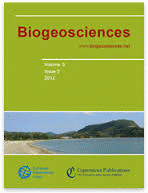Mean annual cycles of runoff, evapotranspiration, leaf area index (LAI) and potential vegetation were modelled for Mesoamerica using the SVAT model MAPSS with different climatology datasets. We calibrated and validated the model after building a comprehensive database of regional runoff, climate, soils and LAI. The performance of several gridded precipitation climatology datasets (CRU, FCLIM, WorldClim, TRMM, WindPPT and TCMF) was evaluated and FCLIM produced the most realistic runoff. Annual runoff was successfully predicted (R2=0.84) for a set of 138 catchments, with a low runoff bias (12%) that might originate from an underestimation of the precipitation over cloud forests. The residuals were larger in small catchments but remained homogeneous across elevation, precipitation, and land-use gradients. Assuming a uniform distribution of parameters around literature values, and using a Monte Carlo-type approach, we estimated an average model uncertainty of 42% of the annual runoff. The MAPSS model was most sensitive to the parameterization of stomatal conductance. Monthly runoff seasonality was mimicked "fairly" in 78% of the catchments. Predicted LAI was consistent with MODIS collection 5 and GLOBCARBON remotely sensed global products. The simulated evapotranspiration:runoff ratio increased exponentially for low precipitation areas, highlighting the importance of accurately modelling evapotranspiration below 1500 mm of annual rainfall with the help of SVAT models such as MAPSS. We propose the first high-resolution (1 km2 pixel) maps combining average long-term runoff, evapotranspiration, leaf area index and potential vegetation types for Mesoamerica.
Download:
DOI:
https://doi.org/10.5194/hess-14-1801-2010
Altmetric score:
Dimensions Citation Count:
























